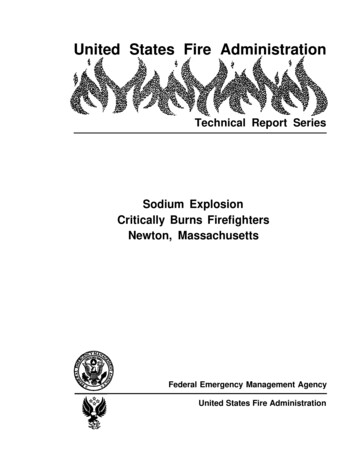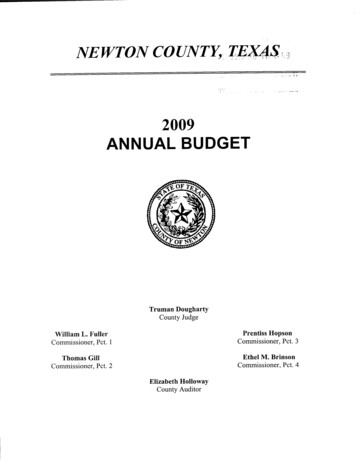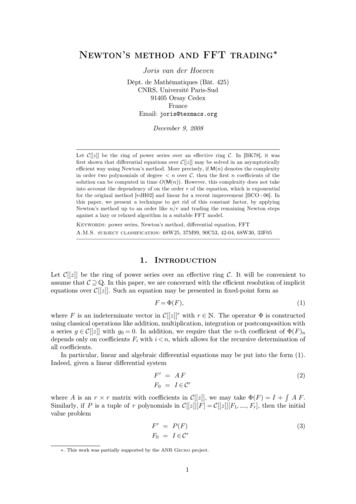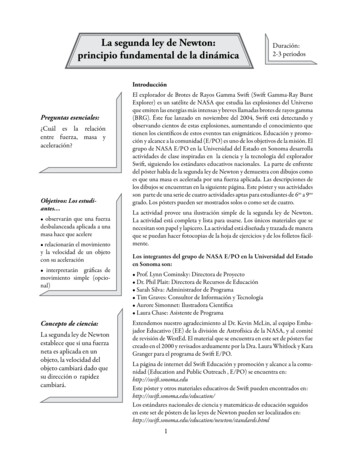
Transcription
Topic 4: Dynamics – Force, Newton’s Three Laws, and FrictionSource:Conceptual Physics textbook and laboratory book plus the CPO textbookand laboratory bookTypes of Materials: Textbooks, laboratory manuals, demonstration, worksheets and activitiesBuilding on:Once the student has worked with motion from the previous topic ofkinematics, velocity and acceleration has been introduced. This now allowsfor the study of the cause of motion, force. A series of labs shows thestudent Newton’s 2nd law and its specifics. First, the student discovers thata constant force produces constant acceleration. Secondly, the studentdiscovers that acceleration is directly proportional to the net force andinversely proportional to a body mass. Also, labs showing Newton’s 1st and3rd law need to be performed. After understanding Newton’s laws, the topicof the conservation of work and energy is explored. Friction is so much of areal thing that it cannot be ignored; thus it will be studied. When consideringnet force, friction must be included to confirm that acceleration is directlyproportional to the net force.Leading to:Once kinematics and dynamics have been studied, the student can thenstudy the conservation of energy, the conservation of momentum and theconservation of angular momentum (for older students, probably not forfreshman).Links to Physics:After the study of kinematics and dynamics, centripetal force and circularmotion including satellite motion can be explored. Dynamics explains whysmall cars can be powered by a 4-cylinder engine and a large truck willprobably have a V8 for power. The aerospace industry needs to totallyunderstand dynamics to put satellites in orbit or send people to the moon.High-energy physics needs to apply dynamics as modified by relativityprinciples to accelerate charged particles down the various accelerators. Allindustries need to understand dynamics to some degree, such as in buildingtrades for constructing the house structure.Links to Chemistry: Force and Newton’s laws are discussed when comparing mass and weight.Weight on different planets may also be discussed to help explain thedifference between mass and weight. Force per unit area (pressure)frequently is covered in chemistry when discussing air pressure and gases.In regard to properties of matter, friction is a topic that arises.Links to Biology:The motion of a humming bird, the movement of a snake, the forces withinmuscles in the human body for contraction and extension are some examplesof dynamics within living systems. Force can be taught in biology classwhen discussing the heart and blood flow. The blood can exert a force on
the blood vessels—blood pressure. Conceptually, the harder the force is, thehigher the blood pressure. The build-up of plaque will decrease the crosssection of the vessel and lead to a higher pressure. One can even discussfluid mechanics at this time. Other examples of force are the force that aroot or earthworm must exert on soil to move the soil or the force that anembryo must exert to break out of a seed coat or animal to break out of anegg.Materials:(a) Hewitt1. Lab 8 – Going Nuts2. Lab 9 – Buckle Up3. Lab 10 – 24-Hour Towing Service4. Lab 11 – Getting Pushy5. Lab 12 – Constant Force and Changing Mass6. Lab 13 – Constant Mass and Changing Force(b) Hsu1. Lab 2A – Law of Inertia2. Lab 2B – Newton’s 2nd Law(c) My Labs1. Constant Force Produces Constant Acceleration2. Constant Mass, Vary Force, Measure “a”3. Constant Force, Vary Mass, Measure “a”4. Friction(d) WorksheetsNewton’s Law Questions and Problems(e) DemonstrationsNewton’s 1st Law1. Toilet Paper Pull2. Cart and Figure with/without Seatbelt3. Coin into CupNewton’s 2nd Law1. Change Mass of Cart being Pulled by Same Force2. Change Force on Same CartNewton’s 3rd Law1. Skateboard, Student and Wall2. Fan Cart on Desk3. 2 Skateboards, 2 Students
(f) Websites and Videos1. ESPN SportsFigures “That Mu You Do” Video Guide(NASCAR Racing)2. Forces in 1-Dimension Lab Sim (Java)3. The Ramp Lab Sim (2-D) (Java)4. www.nextvista.org/tag/newton9627s-law(Demo with eggs; demo with rest and moving objects)(g) Good Stories1. The Wrath of Newton2. Newton’s Birthday
Topic 4: C-1 – Constant Force LabPurpose:To see the effect of a constant applied force to a body has on its motion.Equipment: Dynamics cartTicker timer with power supply and carbon paperTicker tapeOne rubber band (about 6” long – available through Cenco, Sargent-Welch, etc.)Level horizontal tableMeter stickBumper with C clamps to stop the cart at the end of the tableDrawing:Meter StickTapeTimerCartStopRBProcedure:1. Get the timer functioning well. Thread the ticker tape through the timer and attach to thecart.2. With the cart starting near the timer and at rest, pull the tape tight and attach the rubberband to the peg on the cart and the other end of the RB to the end of the meter stick.3. With only the rubber band pulling (hands off), keep the rubber band stretched the SAMEAMOUNT (maybe 10 cm-20 cm). Keep this EQUAL FORCE applied to the cart as youpull the cart across the table to the stop. The timer should be running to put dots on thetape.4. Choose a dot on the tape near, but not at the start of motion, and count all the dots untilthe cart strikes the stop.5. Depending on the number of dots, divide the tape into 5 to 10 equal TIME intervals(rounding will likely occur). As an example, if you count 62 dots across the tape and youdivide the total interval into 10 equal times, 62 divided by 10 6 equal time intervals.6. Measure the length of each interval and put these values into a table.7. To make life easy, let each interval be 1 s. Divide each interval distance by 1s and recordthese average velocities in your table.8. Record the total time in your table. For the example data, times of 1 s, 2 s, 3 s, 4 s, 5 s,and 6 s would be recorded.9. Now calculate the CHANGE in velocity between each interval and record. Lets say oneinterval average velocity is 4 cm/s from 1 s to 2 s and 7 cm/s from 2 s to 3 s, so the
CHANGE in velocity is 3 cm/s between 1.5 s and 2.5 s (the change in time is 1 s).Therefore, 3 cm/s divided by 1 s equals 3 cm/s/s acceleration.10. Draw and plot an average velocity vs. total time graph and state your conclusion aboutthe motion when a constant force is applied to a body.
Topic 4: C-1 – Constant Force Lab Answer SheetFor the Made-up Data Given:IntervalDistance(cm)149162536IntervalAverage Velocity(cm/s)149162536Change inAverage Velocity(cm/s)Average Velocity vs. Total Time Graph357911TotalTime(s)123456
This graph is linear showing that the change in velocity in a given amount of time is constant.Since the change in velocity divided by the change in time is constant, this is the definition ofacceleration; soA CONSTANT FORCE PRODUCES CONSTANT ACCELERATION.For This Made-up Data:a (11 cm/s - 3 cm/s) / (6 s - 2 s) 8/4 2 cm/s/s
Topic 4: C-2 – Newton and AccelerationTitle:Acceleration of a constant mass with a variable forcePurpose:To determine how the acceleration of the same mass is affected when the appliedforce is varied.Theory:Lab C-1 showed that a constant force produces a constant acceleration on a constantmass. Now, asking the question of how does the size of the force affect theacceleration of a constant mass, one can intuitively predict that a huge force willmake a mass accelerate faster than a small force. However, is the relationship linear?Taking data in this lab will answer the relationship question.Procedure:1. Find two long rubber bands as used in Lab C-1 that nearly exert the same force on aspring scale when stretched the same amount.2. Using trial and error, find a force that produces a small visual acceleration. Measurethat force with a spring scale calibrated in Newtons and record in Newtons (forexample, let’s say the force is 2.0 N). Pull the ticker tape as in Lab C-1, record theforce in a table; calculate the acceleration and record in a table. You might find iteasier if the cart is always loaded with about 2 kg.3. Using one or two rubber bands, exert a stretch that doubles the force in procedure 2and repeat procedure 2.4. Repeat procedure 2 with three times the force, four times the force and if humanlypossible, five times the force. For these greater forces, be sure to check the “stop” asyou go to prevent injury! Record the forces and the calculated accelerations in thetable.5. Plot acceleration vs. force graph and compare the shape of the graph to knownmathematical relationship shapes and state your conclusion.Sample Acceleration Calculation from a Tape: (1 s to go 2 spaces)6 cm18 cmSo, a (18 cm/1 s – 6 cm/1 s) / (1.5 s - 0.5 s) 12 cm/s/s.
Topic 4: C2 – Newton/Acceleration Answer SheetQuestion: How does the acceleration of a constant mass depend on the applied force?Sample Data from Ticker Tape:Smallest Force4 cm10 cmLet the time to go 4 cm be 1 s; let the time to go 10 cm be 1 sso, a (vf - vi ) / (tf - ti) (10 cm/s – 4 cm/s) / (1.5 s - 0.5 s) 6 cm/s/s.At 2X the force, a 12 cm/s/s.At 3X the force, a 18 cm/s/s.At 4X the force, a 24 cm/s/s.At 5X the force, a 30 cm/s/s.30Sample Graph2418Acceleration(cm/s/s)1260012 3 4Force (N)5For a real graph with friction, the graph above will be shifted to the right but still parallel to thesolid linear graph both showing a linear relationship between “a” and “F.” Or, a ! F.
Topic 4: C-3 – Newton – Mass and Acceleration RelationshipTitle:Acceleration of Different Masses Using the Same ForcePurpose: To determine how acceleration is related to different masses when the force is thesame. Assume the force is always greater than friction.Theory: Labs C-1 and C-2 have shown that a constant force produces constant acceleration ona given mass and the acceleration of a body is directly related to the applied force.Now we will investigate the relationship between the acceleration of a body and thebody’s mass. To do this we will keep the same force on larger and larger masses.Procedure:1. Using the same procedure as in Lab C-1, pull the dynamics cart with one or two rubberbands at a very quick acceleration while keeping the force constant. Calculate theacceleration using the procedure as in C-2. Record.2. Add 1 kg and repeat procedure 1. Add 2 kg and repeat procedure 1. Also repeat for 3kg, 4 kg, and 5 kg. Mass the cart in kg.3. For each ticker tape pulled, 1 kg, 2 kg, 3 kg, 4 kg, 5 kg added to the cart, calculate theacceleration of the cart.4. Plot a graph of the acceleration of the cart as a function of the added mass (just theadded mass—not with the cart).5. What is the relationship between the acceleration of a mass and its mass when using aconstant force?6. Combine the results of Topic 4, Lab C-2 and this lab, C-3, to form an equation.
Topic 4: C-3 – Newton – Mass and Acceleration Relationship Answer SheetSample Data: Constant ForceCart Mass 1 kgAdded Mass(kg)12345Total Mass of Cartand Added Mass .06.0A(cm/s/s)4.02.00.001234M (kg)56These curves show an inverse relationship, or, a ! 1/m.A check on the inverse relationship can be done if a times m equals a constant.This sample data shows:1 x 10 102 x 5.0 103 x 3.3 104 x 2.5 105 x 2.0 10The constant 10 for these sample data points shows an inverse relationship.
6. Since a ! F (C-2) and a ! 1/M (C-3), combining gives a ! F/M; thus, a (constant) F/M.The constant turns out to be 1 due to definitions of units, soa F/M or F MANewton’s 2nd Law!!!
Topic 4: C-4 – FrictionPurpose:To find the relationship between the forces that pushes two surfaces together and thefriction that results.Theory:As many people know, during the snowy winter, car drivers of rear drive cars putweight in their trunk to gain traction. In this activity, the relationship between theweight of the back of the car and the traction will be explored. The term for the pushof the back wheels against the ground is the normal force because it is perpendicular.The term for traction is friction. One can think of the force pushing the two surfacestogether as the normal force, but the upward force of the road pushing up is definedas the normal force. The two surfaces for this example are the road surface and thetires.In this activity, the normal force (F!) is numerically equal to the weight of a block ofwood and what is placed on top of the wood. The friction (Fr) will equal the pullingforce of a spring scale if the speed of the block is constant. The two surfaces are woodon wood. When the block is propelled forward with a force that results in constantspeed, the opposing friction force matches the pulling force, so F(net) 0. Recall thatF(net) ma, so when F(net) 0, a 0.Draw and label the weight (W) of the block on the sketch. Also draw and label the normal force(FN), the applied force (FA) and the friction (Fr).Materials: Any two materials can be used, but for this lab, wood on wood is the choice. Cut a2” x 4” block about 6” long and insert an eyehook in the center of one end. Use a 1” x6” board about 6’ long for the flat horizontal surface. A spring scale that reads up to20 N is used to pull the 6” block across the board. Use a loop of string to use betweenthe block and spring scale to be more convenient. Five one-kilogram interlockingweights will be needed.Procedure:1. Weigh the block of wood in Newtons. Record.2. Place the block at one end of the horizontal board. Attach the cord and spring scale to theeyehook. Zero the spring scale.
3. Add 1 kg to the block. Pull horizontally on the block with a constant speed across theboard. Read the scale while moving. Record. How does the pulling force compare to theopposing frictional force?4. Repeat procedure 3, but with 2 kg aboard, 3 kg, 4 kg, and 5 kg aboard. Record theseforces.5. In your data table, make a new column for the added weights and the weight of the block.How does the total downward force compare to the upward normal force?6. Plot a graph of the frictional force (Fr) as a function of the normal force (F!).7. What is the shape of the graph? What is the math relationship between Fr and F!?8. Is the slope constant or varying?9. What is the value of the slope of the graph? Compare your value with a textbook value.What is the meaning of this slope?Other Optional Items to Check:1. Pull at different constant speeds (slow and fast) to see what, if any, affect speed has onfriction.2. Do different materials: cloth on wood, metal on metal, etc., to see what affect this has onfriction.3. Compare starting friction to moving friction by comparing the pulling forces.4. See if surface area changes the friction (in this activity, turning the block on its sidewould halve the surface area, thus a 2 to 1 ratio).5. Try at hot and cold conditions.
Topic 4: C-4 – Friction Activity Answer SheetDrawing:FNFrFAWReasonable Sample Data:Weight of Board 1.0 NAdded Weight (N)W9.819.629.439.249.0Normal Force including Block (N)FN10.820.630.440.250.0Applied Force, also Friction (N)Fr2.24.26.18.010.03. Pulling force Frictional force, or FA Fr5.Same, FD FN (up)6.1086Fr (N)4200102030FN4050
7.Slope is a straight line, or the curve is linear. This is a direct proportion.Direct proportion exists between Fr and FN, or Fr ! FN.8.Slope is constant.9.Slope is called mu (Greek symbol) and written as: !! Fr / FN (10 - 0) / (50 - 0) N/N 0.2 (no unit)0.2 for wood on wood is about correct. (See tables in textbooks.)The ratio, mu, describes the amount of friction that would exist between twosubstances. If mu is large, large friction; if mu is small, small friction.Optional:1. Mu is the same at all speeds.2. Yes, materials do matter: ice on ice will be small; rubber on concrete is large.3. Starting friction is greater than moving friction, so mu is larger for static friction.4. Surface area has no affect on mu.5. Temperature has no affect on mu.
Topic 4: D-1 – Newton’s Law Worksheet (Questions and Problems)Newton’s 1st Law:1. Galileo revisited: Around 1650, Galileo sketched three ramps as shown below and asked howfar up the other side of the ramp the ball would roll if no friction was present and the ball wasreleased from rest.What is your answer for each of the sketches and why?2. A table and chair with a student are mounted on a platform that is rotated at a constant rate.The table has a frictionless top, and the student propels a frictionless puck at a 45-degreeangle to the table (see the sketch).You are mounted to the ceiling and looking down.Describe what you would see.3. Why can’t you walk if you were on totally frictionless ice?4. Why does a truck in the parking lot just stay there and not move?5. Why does a truck flying down a road at a high rate of speed have so much trouble stoppingquickly?
6. A ball is thrown parallel to the ground by a student. The first Newton law says the ball willcontinue in a straight line, but it doesn’t. Why not?Newton 2nd Law:1. If a net force gets larger on an accelerating mass, how will the mass respond?2. If a truck loaded with bricks is accelerating, but many bricks fall off during acceleration,what will now happen to the motion of the truck?3. Name the math relationship between acceleration and net force on a mass.4. Name the math relationship between acceleration of a mass and the mass.5. If a rocket blasts off from earth and proceeds on its way to the moon, what would happen tothe rocket’s acceleration if you assume the rocket continues to exert the same thrust? Keep inmind that the rocket has a large percent of its mass as fuel. Ask yourself what happens togravity as the rocket leaves the earth.6. The same force is applied to mass A and mass B. Mass A at 40 kg accelerated at40 cm/s/s and mass B accelerated at 20 cm/s/s. What is the mass of B?7. A force acts on mass A giving it an a 5 cm/s/s; the same force causes an a 15 cm/s/s onmass B. What is the ratio of mass A to mass B?8. How long would it take a constant 10 N force to cause 5 kg to accelerate from rest to 20m/s?9.7 cm12 cm2 s between dotsHow big of constant force causes a 2 kg mass to accelerate as shown?10.2 kg4NCalculate “a.”4NCalculate “a.”No friction11.2 kg1 N of friction
Newton’s 3rd Law:1. What is the reason when you push on a wall while standing on a skateboard that youaccelerate away from the wall? Doesn’t the force of you on the wall equal the force the wallexerts on you, and shouldn’t they cancel out?2. Why can you walk on pavement?3. Two equal mass spheres move toward each other at equal speeds. At contact, draw the forceson the spheres and label them F1,2 and F2,1; (F1,2 means mass one pushes on mass 2.) How dothe forces compare?V1V24.CartHorseAccelerateGround(a) How many Newton 3rd law PAIRS of forces are acting on the horse, ground and cart asthe horse/cart accelerate? Identify each.(b) Which pair is the largest?(c) Which pair is the smallest?
(d) Does the horse push forward or backward to accelerate the horse forward?(e) Does the ground return the horizontal push on the horse? Compare the size of these twoforces. Do they cancel out? Why or why not?5.WallHorse 1Horse 2Horse 1(a) Horse 1 pulls on a wall. The wall and horse don’t move, but a lot of tension exists in therope. Does the horse feel the same force as what is within the rope? How big is theforce on the wall?(b) The same horse 1 is attached to identical twin, horse 2; with a rope they pull. Comparethe rope tension now to when horse 1 was pulling on the wall.
Topic 4: D-1 – Newton’s Law Worksheet (Questions and Problems) Answer SheetNewton’s 1st Law:1.Same height; ball repeats same motion—symmetry;easier to explain with energy topic.Same height,same reason.Go forever. No reason to stop since no friction. A body in motion goes forever in a straightline with no external force. Galileo did these very experiments with a hard wood, waxed balland waxed boards and could see his ideas were correct.2. You would see the puck go in a straight line and the table would appear to rotate in a circularpath beneath the ball. If you were in the frame of reference of the table/student, the puckwould travel in a circle.3. You cannot push back on the ice, so the ice can’t propel you forward.4. Since the truck has no horizontal force on it, a body at rest remains at rest.5. A body in motion stays in motion—inertia (mass) too large. Momentum and energy will laterexplain this phenomenon.6. An external force, in this case gravity, acts down on the ball causing it to curve downward.The shape is a parabola.Newton’s 2nd Law:1. Since a ! F, a direct relationship exists; so when F increases, so does acceleration.2. When bricks fall off the truck, the mass decreases, so the acceleration increases with aconstant force.3. Direct relationship4. Inverse relationship
5. Since fuel is used up, the rocket’s mass decreases causing an increase in acceleration.Likewise, the further away from the earth the rocket goes, the smaller the gravity force, soagain, faster acceleration.6. a ! m and F MA, so MAAA MBABOr,(40 kg)(40 cm/s/s) MB (20 cm/s/s), so MB 80 kg7. a ! 1/m, so MA/MB AB/AAMA/MB (15 cm/s/s) / (5 cm/s/s) 3/1 or 38. F MA; F (M)("V) / ("t); (10 N) (5 kg)(20 m/s – 0) / ("t); "t 10 s9. First, a ("v) / ("t); a (12 cm/2 s - 7 cm/2s) / 2 s (6 – 3.5) / 2 1.25 cm/s/s; then,F MA; F (2 kg)(1.25 cm/s/s) 2.5 N10. A F/M; A (4 N) / (2 kg) 2 m/s/s11. A F/M; A (4 N – 1 N) / (2 kg) 1.5 m/s/sNewton’s 3rd Law:1. Reaction. When you push on the wall, the wall pushes back on you with an equal butopposite force that causes your acceleration, a ! F.Yes, the forces are equal, but, no, the forces act on different bodies. You feel one force of thewall.2. Friction. You push back on the pavement and it pushes forward on you (action-reaction).3.F2,1-F1,24. (a) 3 pairs:1. Horse-ground (F horizontal)2. Horse-cart(F horizontal)3. Cart-ground (F horizontal)F2,1 -F1,2equal and opposite
(b)(c)(d)(e)Horse-groundCart-groundBackwardYes; equal but oppositely directed; the force does NOT cancel because the horse feelsone force and the ground feels the second force of the pair.5. Yes; (F on horse F on rope)(a) F on wall same as F on horse and same as F on rope(b) Same tension as when the horse pulled on the wall
Topic 4: E-1 – Dynamics DemonstrationsNewton’s 1st Law: A body at rest will remain at rest if no outside force acts on it; a body inmotion will continue in motion in a straight line if no outside force acts on it.1. Toilet Paper Pull: If you place a dowel rod through the roll and pull slowly, the rollunwinds since it has time to accelerate. If you pull quickly, the individual squares tear offsince the inertia of the roll is large and the time is too small for acceleration.2. Cart and Figure with/without Seatbelt: Use the dynamics cart with a soft, unbreakablefigure like an 8-inch-tall teddy bear riding on top. Get the cart and bear going by slowlyaccelerating them and smash them into a wall. The bear goes flying since—1st law!Repeat by strapping the bear (I use duct tape) down and the bear stays on the cart.3. Coin into Cup: Place a 3” x 5” index card over a cup or beaker and place a coin like aquarter (larger mass) on the card. Flick the edge of the card horizontally quickly withyour finger and the coin falls into the cup—1st law.(Be creative—the list of demos is limited by your imagination.)Newton’s 2nd Law: The acceleration of a mass is directly related to the applied net (total) forceacting on the mass and inversely related to its inertial mass. A F/M1. Change mass of cart being pulled by same force. Like in the Newton lab, pull onedynamics cart with one rubber band so it accelerates quickly. Repeat using the samepulling force but put many kilograms on board to see a dramatic difference (NO numbersneeded here).2. Pull one dynamics cart with one rubber band as in the lab so it accelerates slowly. Nowpull the same cart but with two or more rubber bands so the same mass acceleratesnoticeably quickly. Practice is required to show conceptually the 2nd law.Newton’s 3rd Law: The 3rd law states that when one mass pushes on a second mass, the secondmass pushes back with an equal force but in the opposite direction. Each body feels one force, soeach body will accelerate, not cancel out the other force as some students would predict (actionand reaction). Forces always occur in pairs.1. First, you or a student (safer for you) stands on a skateboard at rest facing a wall andpushes off; the teacher/student accelerates nicely but the wall doesn’t. Ask the whyquestion to the students—why you accelerate but not the wall. The wall is attached to theschool, so its mass is too large and since too much friction prevents the wall fromaccelerating, you will accelerate because the mass is small.2. Use a commercial fan cart or mount a fan on a dynamics cart and ask if the cart
will move and in what direction. Most will get it correct and indicate the air goes one waybut the cart goes the other—3rd law. However, ask to explain how this demo works interms of pairs. The sketch below should help.AirF fan on air F air on fanNow put a sail on the cart and ask if it will work. Also explain in terms of the pair offorces.F air on sail F sail on airF fan on air F air on fanSince F sail on air and F fan on air are equal, then, the F air on sail and F air on fan areequal. The sail and fan are both attached to the boat, so the net force on the boat is zero;thus, the boat stays at rest.
Topic 4: E-2 – Demonstrations of Newton’s Three LawsNewton’s 1st Law:1. Toilet Paper PullPlace a full roll of toilet paper on asmaller dowel rod with little frictionthrough the cardboard tube center.(a) Try to remove 1 sheet when you pull slowly and down. Discuss. (Sheet probablywon’t tear off and will unroll the paper since the time of acceleration is long enoughto not take advantage of the inertia of the mass.)(b) Repeat (a), but pull down quickly.(Will work due to the short time and thus larger force; the inertia of the mass allowsyou to remove 1 sheet.)(c) Repeat (a) and (b), but using a nearly empty roll.Repeat (a) result – One sheet won’t tear because the force is too small as the time ofacting is too long.Repeat (b) result – Might work if you pull fast to make !t small enough for F to belarge enough.)2. Cart and Figure with/without SeatbeltWallF(a) Roll a dynamics cart and stuffed toy of your choosing (rabbit shown) at a wall at highspeed. Observe. (Toy flies into wall causing death; a body in motion stays inmotion—inertia at work. The wall’s force on the cart stops the cart.)(b) Repeat (a) but put a seat belt on the toy (duct tape could be used). Observe. (Toyremains part of vehicle—seat belt GOOD! Can prevent death!)
3. Coin into CupPlace a coin on an index cardabove your coffee cup.Quickly snap a corner of the index card with your finger. Observe. (The card goes flyingand the coin drops into the cup; a body at rest stays at rest.)Newton’s 2nd Law:1.(a) Loop a long rubber band around a rod inserted into a dynamics cart and place a meterstick into the loop of the rubber band and stretch the rubber band as shown. Thestretch should be such that the cart accelerates quickly but at a rate that allows you tomaintain the same stretch.(b) Repeat (a) with a brick atop the cart using the same rubber band and the same stretch.Observe any change.(c) Repeat (a) with 2 bricks atop the cart. Observe.(Students can easily observe that using the SAME FORCE on INCREASINGMASSES results in DECREASING ACCELERATIONS. A ! 1/M)2.(a) Use the procedure as in 1 with 1 brick on the cart but pull with a force that causes asmall but noticeable acceleration.(b) Again use one brick but use 2 identical rubber bands at the same stretch to acceleratethe cart. Observe any change.(c) Repeat with 3 rubber bands. Observe.(Students will easily see that INCREASING THE FORCE CAUSES THEACCELERATION TO INCREASE. A ! F)Newton’s 3rd Law:1. You or a coordinated student stands on a skateboard next to a wall.
The rider pushes off from the wall. Explain what took place.(This is a straightforward action-reaction example. Rider pushes the wall [action] and thewall pushes back with an equal but oppositely directed force [reaction].)2. Use a cart from most scientific supply companies that has an electric fan/motor mountedto a lightweight low-friction cart.SailFan/Motor(a) Ask students which way the cart will move (or not move) when NO SAIL is attachedto the cart. Establish which way the wind blows as you hold the cart at rest and hold asheet of paper in front of the sail. Have the students discuss what will happen beforeyou turn on the fan. Turn on the fan.(In this sketch, the wind blows to the left so the cart goes to the right. This vectorsketch should help.Force on windForce on sail, thus the cartThe wind feels one force of the action-reaction pair and the cart feels the other ONEFORCE to the right, so it accelerates to the right.)3. Have two coordinated students—one small and the other larger—stand on skateboards asshown. Ask what will happen as they push off from each other? So, 3, 2, 1, go andobserve.(Since FS,L - FL,S and F MA, we get Ma -mA, which shows the larger person has asmaller acceleration and the smaller person a larger acceleration.)LSMa -mA
Newton’s Two BirthdaysIt is customary to celebrate the birthday of Isaac Newton on Christmas Day 1642.Newton was considerably premature at birth and was given little hope of survival. It was saidthat he was small that he could be fitted into a quart pot. Newton’s father (also an Isaac) had diedthree months earlier, which left, Hannah, his mother, the task of raising the lad.Today we can celebrate Newton’s birthday twice, first on December 25 and on January 4.On the day of Sir Isaac’s birth, it was December 25, 1642 only in England. For the rest of Europeit was already January 4, 1643.Since the year 355 A.D., the Christian calendar had designated March 21 as the day ofthe vernal equinox. A
3. Lab 10 - 24-Hour Towing Service 4. Lab 11 - Getting Pushy 5. Lab 12 - Constant Force and Changing Mass 6. Lab 13 - Constant Mass and Changing Force (b) Hsu 1. Lab 2A - Law of Inertia 2. Lab 2B - Newton's 2nd Law (c) My Labs 1. Constant Force Produces Constant Acceleration 2. Constant Mass, Vary Force, Measure "a" 3.










